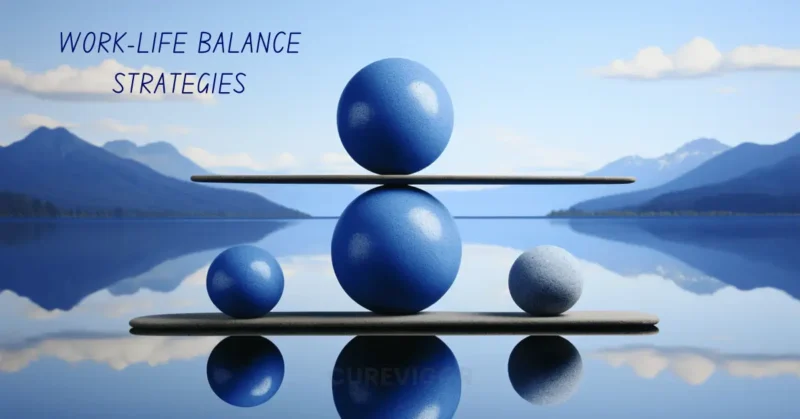Learn science-backed Work–Life Balance Strategies that help you manage time better, stay energized, and achieve a happier, more fulfilling life.
Thank you for reading this post, don't forget to subscribe!Did you know that 77% of professionals say they’ve experienced burnout at least once in their careers, and the average person now spends over 7 hours a day staring at screens?
That’s not just draining your energy—it’s quietly stealing your happiness, focus, and time.
How to Achieve Work–Life Balance Strategies
In today’s fast-paced world, maintaining a healthy work–life balance feels more like a myth than a reality. Yet, the truth is you can reclaim your time and happiness by applying the right strategies—backed by science.
When you respect boundaries, prioritize self-care, manage your time smartly, and choose what matters most, you build a life that supports both your career and your personal well-being.
And yes, work-life balance isn’t just a nice-to-have—it’s a necessity.

In this blog post, we’ll explore exactly why that is and then walk through 15 science-backed, proven work-life balance strategies you can apply starting today. Let’s dive in.
The Importance of Work–Life Balance Strategies
Work–Life Balance Strategies to Reduce Stress
One of the fundamental benefits of work-life balance is stress reduction. Research shows that when people can align their work and non-work activities in a way that feels compatible, they experience lower levels of emotional exhaustion, anxiety, and depression.
When you constantly blur the line between professional duties and personal life, your brain remains in “on” mode, triggering stress hormones and reducing your capacity to recover.
By permitting yourself to switch off, you give your nervous system a break.
In short: less stress, better mood.
Work–Life Balance Strategies for Better Relationships
Your relationships—whether with family, friends, or yourself—get stronger when you balance work and life well.
When you bring your whole self to interactions (and you’re not drained from overworking), you connect more genuinely.
Research indicates that a work-life balance is associated with increased life satisfaction, family satisfaction, and personal well-being.
When your non-work life gets neglected, resentment builds, time together becomes rushed, and quality suffers. By consciously protecting personal time, you protect your relationships.
Work–Life Balance Strategies to Boost Productivity
Contrary to the common belief that working longer means achieving more, research shows that work–life balance strategies actually enhance productivity and overall performance.
Studies reveal that individuals who maintain a healthy work–life balance experience higher job satisfaction, creativity, and emotional well-being.
When you’re well-rested, mentally centered, and not overwhelmed by burnout, your focus and problem-solving skills improve naturally.
Adopting effective Work–Life Balance Strategies isn’t about doing less—it’s about working smarter, sustaining energy, and achieving long-term success without sacrificing your happiness.
15 Proven Work-Life Balance Strategies
Implementing work–life balance strategies is essential to create harmony between your professional goals and personal well-being.
These proven techniques help you manage time effectively, reduce stress, and build stronger relationships.
By applying even a few of these work–life balance strategies, you can boost productivity, protect your mental health, and reclaim control over your life.
Let’s explore 15 simple yet powerful ways to achieve lasting balance.
Set Clear Boundaries

Establish a clear distinction between work and personal life.
Boundaries are the guardrails that keep your work from bleeding endlessly into your private time. When you set clear start and end times, decide where you’ll work and not work, and clarify what you will and won’t do, you regain control.
For example, no checking email after 7 pm, or working only at your desk and not on the couch. These rules create space for personal life.
Tip: Communicate those boundaries with colleagues and loved ones so everyone knows the expectations.
Prioritize Self-Care
Make time for activities that nourish your mind, body, and spirit
Self-care isn’t indulgence—it’s foundational for your well-being. It might be meditation, a daily walk, reading, hobbies, or simply doing nothing.
When you skip self-care, you set yourself up for fatigue and diminished returns.
Studies show that healthier, happier employees are more productive and less prone to injury or illness.
Action: Schedule self-care slots like any meeting and stick to them.
Time Management in Work–Life Balance Strategies
Use tools such as calendars, to-do lists, and time-blocking methods to manage your time effectively.
Time management is a non-negotiable in reclaiming balance. The day can get away from you unless you track, prioritize, and block time.
Some techniques:
- Use a calendar to block both work and personal tasks.
- Create a realistic to-do list and prioritize 2–3 “must-dos” each day.
- Use time-blocking: designate specific chunks for focused work, breaks, and personal life.
These techniques minimize the feeling of “I don’t have time” and help make your free time meaningful.
Learn to Say No at Work and Home
Set healthy boundaries by learning to say no to commitments that drain your energy.
Saying “yes” to everything is a fast track to imbalance. Every time you say yes to work or obligations that don’t align with your priorities, you increase stress, reduce personal time, and weaken your ability to perform.
It’s okay to say no—to an extra meeting, a volunteer role, a new project—if it means preserving your energy, rest, or personal life.
Tip: Use a phrase like “Thanks for thinking of me; I’ll need to pass so I can focus on ___.”
It’s polite, clear, and preserves your boundaries.
Take Breaks
Take regular breaks to recharge and reduce burnout
Breaks are essential. Studies of “micro-breaks” (short breaks of 10 minutes or less) show they help reduce fatigue and boost feelings of energy.
You don’t have to wait until you’re exhausted—build breaks in. Maybe a 5-minute walk every hour or a 15-minute pause after a major task.
Bonus: When you’re rested, you actually accomplish more with less strain.
Practice Mindfulness
Regular mindfulness practice can help reduce stress and increase self-awareness
Mindfulness is more than a buzzword. Research with IT workers shows mindfulness programs increased mental well-being and perceived productivity.

Mindfulness strengthens your ability to stay present, reduce rumination about work when you’re off, and regulate emotions.
Try: 5 minutes of breathing at the start of the day, a short body-scan before bed, regular check-ins on your feelings. Over time, you get better at recognizing when work is creeping into your personal time.
Schedule Personal Time
Treat personal time with family and friends as non-negotiable.
Your calendar isn’t just for work. When you block time for family, friends, hobbies, or personal rest and treat it like a real appointment, you protect it.
Examples: Sunday brunch with friends, game night with family, a solo hike. Write it down. Respect it.
By doing this, you signal that your personal life matters just as much as your work—because it does.
Disconnect from Work
Avoid checking work emails or taking work calls during personal time.
The laptop isn’t your only companion after hours. The “always-on” culture steals personal time and undermines recovery.
Research shows hybrid and flexible working can improve work-life balance—but only if disconnecting is respected.
Turn off notifications. Set a clear “end of work day” ritual. Communicate your availability and stick to it.
Your relationships, your rest, your creativity—they all win when you unplug.
Get Enough Sleep
Aim for 7-9 hours of sleep per night to improve physical and mental health.
Sleep is the reset button for your brain and body. When you skimp on sleep, you’re more vulnerable to stress, less sharp, and less resilient.
Prioritizing sleep supports both your professional performance and your personal satisfaction.
Tip: Keep your sleep schedule consistent, wind down 30 minutes before bed without screens, and treat sleep as non-negotiable.
Stay Active
Regular exercise can improve mood, energy, and overall well-being.
Physical activity is a cornerstone of well-being. When you move your body, you boost your energy, improve your mood, reduce stress, and sharpen your focus.
By integrating exercise into your routine, you’re investing time in your ability to handle both work and life demands.
Action: Even 20–30 minutes a day—walking, stretching, cycling—can make a big difference.
Seek Support
Build a support network of family, friends, and colleagues
No one succeeds alone. Support networks give you perspective, emotional backup, help with tasks, and accountability.
If you struggle with work-life balance, talk to a friend, mentor, or colleague. Share goals. Ask for help. You’ll find that simply expressing your needs strengthens your resilience. And you’ll feel less isolated.
Re-Evaluate Priorities
Regularly assess priorities and make adjustments as needed.
What you prioritize today might not suit you next month. Life changes (kids, health, new job, new hobby) call for adjustment.
Set aside time each month or quarter to ask: What matters now? What’s draining me? Where am I over-committed?
When you re-evaluate consistently, you keep your life aligned with your values and reduce misdirection.
Use Technology Wisely
Use technology to streamline work and personal tasks, but avoid overuse

Technology is a double-edged sword. It can help you automate, schedule, collaborate, and free up time. But it can also blur boundaries, distract endlessly, and tether you to work.
Utilize tools effectively: set calendar alerts, use task apps, and automate routine tasks.
Establish boundaries: refrain from checking emails after hours, limit social media usage, and keep work applications separate from personal ones.
You’ll retain the benefit and avoid the burnout.
Practice Gratitude
Focus on the positive aspects of life and express gratitude
Gratitude rewires your brain. It is one of the best Work-Life Balance Strategies.
When you regularly pause to appreciate what’s going well—your health, relationships, opportunities—you shift your perspective from scarcity to abundance.
That shift improves mental health, reduces stress, and fosters resilience.
Try a daily gratitude habit: list three things you’re grateful for before bed, or write a quick thank-you note to someone. Small action, big return.
Seek Professional Help
If needed, seek help from a mental health professional
Finally, if you feel persistently overwhelmed, anxious, or stuck despite your best efforts, it’s wise to seek professional support.
Mental health professionals can help you identify patterns, build coping strategies, and regain equilibrium.
There’s no shame in needing help—there’s strength in recognizing when support will accelerate your recovery.
By doing so, you honor your well-being and ensure work-life balance isn’t just a goal—it becomes sustainable.
Benefits of Work–Life Balance Strategies
Improved Mental Health
Work-life balance strongly supports better mental health. Research shows that when work and life are aligned, individuals experience lower stress-related outcomes, such as psychological distress and emotional exhaustion.
When you give yourself time to rest, reflect, connect, and recover, you protect your mental well-being.
Increased Productivity
As noted earlier, work-life balance doesn’t mean “less work” only—it means smarter work. Evidence shows a positive link between balance and job satisfaction, which in turn boosts job performance.
In other words, you’ll do better by working with balance, not against your own rhythm.
Better Relationships
When you show up rested, present, and with emotional bandwidth, your relationships thrive. Work-life balance supports family satisfaction, social connection, and a fulfilled personal life.
These relationships are the anchor of your well-being—and they feed your happiness.
FAQs About Work–Life Balance Strategies
Q. What is the 20-20-20 rule for work-life balance?
The 20-20-20 rule is a simple technique designed to protect your eyes, mind, and focus while working. Every 20 minutes, look at something 20 feet away for 20 seconds. This micro-break reduces digital eye strain and helps reset your concentration.
Beyond the physical benefit, it’s also a mini mental reset that prevents burnout from prolonged screen time.
Regular use of this rule promotes better posture, sharper focus, and improved work-life balance throughout your day.
Q. What is the 888 rule for work–life balance?
The 888 rule divides your day into three balanced parts—8 hours for work, 8 hours for personal life, and 8 hours for rest. It’s a simple framework that ensures no single area dominates your life.
This rule reminds you to give equal importance to productivity, recovery, and leisure. By following it, you maintain energy, reduce stress, and build a more sustainable routine.
It’s not rigid—it’s a guiding principle to help you plan a healthier, more intentional day.
Q. What strategies do you use for maintaining your work-life balance?
To maintain a healthy work-life balance, I rely on a mix of structure and flexibility. I set clear work boundaries, schedule personal time, and use time-blocking to stay focused.
Regular breaks, mindfulness practices, and digital detoxes help me recharge. Prioritizing self-care—like exercise and quality sleep—keeps my energy stable.
I frequently reassess my priorities to ensure my goals align with my values and lifestyle. Balance isn’t static; it’s about constant adjustment.
Q. What are the six components of work-life balance?
The six essential components of work-life balance are time management, setting boundaries, self-care, nurturing relationships, maintaining mental health, and finding purpose.
Time management ensures efficiency; boundaries protect your personal time. Self-care maintains your physical and emotional health, while strong relationships provide social support.
Mental health helps you stay resilient under pressure. Lastly, purpose gives your work and life deeper meaning—helping you feel fulfilled in both domains. Together, these create a balanced, satisfying lifestyle.
Q. What is the 3-3-3 rule for working?
The 3-3-3 rule is a focus technique to boost productivity and prevent burnout. It suggests dividing your workday into three main tasks, three short breaks, and three major goals for the day.
By doing this, you avoid overloading yourself with endless to-dos. It keeps your day structured yet manageable, allowing you to make steady progress without feeling overwhelmed.
The rule promotes mindfulness, intentionality, and a sense of accomplishment at the end of each day.
Q. What is the healthiest shift to work?
The healthiest shift to work is generally the day shift, aligning with your body’s natural circadian rhythm. Working during daylight hours helps regulate sleep, hormones, and energy levels.
People who work consistent day shifts often experience better mental health, stronger immune systems, and improved social connections.
However, for night or rotating shift workers, maintaining a regular sleep schedule, exposure to natural light, and proper nutrition can help mitigate health risks. Consistency is key to well-being.
Conclusion About Work–Life Balance Strategies
Reclaiming your time and happiness through work-life balance is both possible and necessary. The 15 strategies above—backed by research and grounded in real life—give you a roadmap to build a more balanced and fulfilling life.
From setting clear boundaries to practicing gratitude, from time-management techniques to seeking professional support—you have tools.
Use them.
Start small. Pick one strategy this week. Build momentum.
Over time, you’ll see your stress reduce, your productivity climb, your relationships strengthen, and your sense of happiness deepen.
Because work-life balance isn’t a luxury—it’s a foundation for a life worth living.
You deserve that balance. You deserve that happiness.
Get more Health and Balance insights.
You might love:



